
Once railway station is a large railway terminus in central Buenos Aires, Argentina, in the barrio of Balvanera.

Trenes de Buenos Aires (TBA) was a private company that operated commuter rail services over the 5 ft 6 in broad gauge Sarmiento and Mitre lines of Buenos Aires. The company, owned by Claudio and Mario Cirigliano, also operated long-distance services on the General Mitre Railway to central-western Argentina and on the General Urquiza Railway to northern Argentina and Uruguay on the international Tren de los Pueblos Libres.

Tren de la Costa is a suburban 15.5 km (9.6 mi), 11-station light rail line in Greater Buenos Aires, between Maipú Avenue station in the northern suburb of Olivos and Delta station in Tigre, on the Río de la Plata. The line connects with the Mitre line at Maipú station, via a footbridge across Avenida Maipú, for direct access to Retiro terminus in central Buenos Aires.

The Buenos Aires–Rosario–Córdoba high-speed railway was a project designed to link the Argentine cities of Buenos Aires, Rosario and Córdoba through a 710 km (440 mi) high-speed rail network. The plan, announced by then-President Néstor Kirchner during a press conference at the Casa Rosada on 26 April 2006, would have been the first in Argentina operating at up to 320 km/h (200 mph). The entire project was dismissed due to the financial crisis of 2007–08.
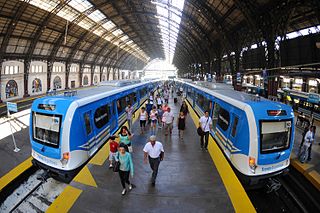
The Mitre line is an Argentine broad gauge commuter rail service in Buenos Aires Province and is part of the Ferrocarril General Bartolomé Mitre division. The service is currently operated by the State-owned company Operadora Ferroviaria Sociedad del Estado after the Government of Argentina rescinded its contract with Corredores Ferroviarios in March 2015.

The Sarmiento line is a broad gauge commuter rail service in Buenos Aires Province, Argentina, run by the state-owned Trenes Argentinos since 11 September 2013.

Railway privatisation in Argentina was a process which began in 1993 under the presidency of Carlos Menem, following a series of neoliberal economic reforms. This primarily consisted of breaking up the state-owned railway company Ferrocarriles Argentinos (FA) and allowing the former lines to be operated by private companies instead of the state. This policy was met with widespread criticism and proved catastrophic for the Argentine railways whose service worsened significantly in the years that followed, with entire lines closing and infrastructure deteriorating beyond repair. Privatisation was ultimately reversed in 2015 with the creation of Nuevos Ferrocarriles Argentinos.
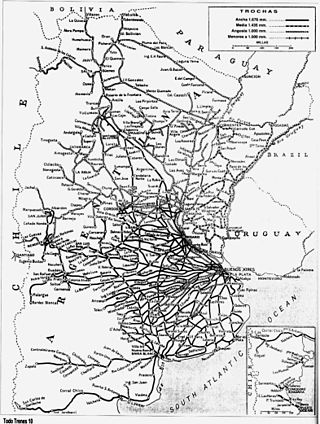
The Argentine railway network consisted of a 47,000 km (29,204 mi) network at the end of the Second World War and was, in its time, one of the most extensive and prosperous in the world. However, with the increase in highway construction, there followed a sharp decline in railway profitability, leading to the break-up in 1993 of Ferrocarriles Argentinos (FA), the state railroad corporation. During the period following privatisation, private and provincial railway companies were created and resurrected some of the major passenger routes that FA once operated.

The Benavídez rail disaster, which occurred on February 1, 1970, is the worst-ever rail disaster in Argentina and South America, leaving 236 dead and more than 500 injured.
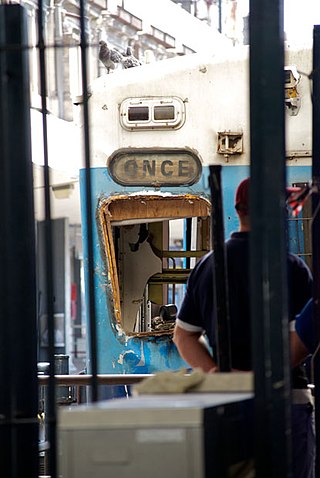
The 2012 Buenos Aires rail disaster, also known as the Once Tragedy, occurred on 22 February 2012, when a train crashed at Once Station in the Balvanera neighbourhood of Buenos Aires, Argentina.

The 2011 Flores rail crash occurred at 06.23 ART on 13 September 2011 when a bus on a level crossing at Flores railway station, in the Flores barrio of Buenos Aires, Argentina, was hit by a train on the Sarmiento Line, heading for Moreno. The accident caused that same train to smash into another one as it derailed.

The Brandsen rail disaster occurred on March 8, 1981, in Brandsen, a town in Buenos Aires Province in Argentina, when a passenger train carrying 803 passengers collided head-on with a freight train, killing 34 and injuring another 74. The train crash was caused by points failure.

Unidad de Gestión Operativa Mitre-Sarmiento (UGOMS) was a temporary consortium of Argentine companies formed on 24 May 2012 by Ferrovías and Metrovías to take over the running of the Sarmiento and Mitre commuter rail lines, after concessions granted to Trenes de Buenos Aires (TBA) in 1995 for the operation of these services were revoked.
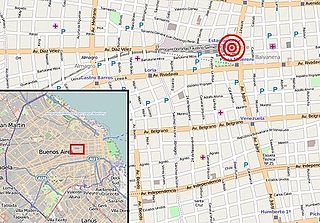
The Buenos Aires train crash occurred on October 19, 2013 when a passenger train failed to stop at a terminal station in Buenos Aires, Argentina, injuring 105 people. As of October 2013, the cause of the accident was sleeping at the controls.

Operadora Ferroviaria Sociedad del Estado is an Argentine state-owned company created in 2008 to operate passenger services in Argentina. It is a subsidiary of the Ferrocarriles Argentinos holding company.

Corredores Ferroviarios was an Argentine private company that operated the Mitre and San Martín railway services in Buenos Aires Province for about one year until the Government of Argentina rescinded the agreement with the company in March 2015. Since then, the Mitre and San Martín line are operated by State-owned company Operadora Ferroviaria Sociedad del Estado (SOFSE).

The Tren de los Pueblos Libres was an 813-km length rural railway line that connected Argentina and Uruguay, being operated by both the Argentine private company Trenes de Buenos Aires (TBA) on General Urquiza Railway standard gauge rail tracks, and Uruguayan the State-owned State Railways Administration of Uruguay "Administración de Ferrocarriles del Estado" (AFE).
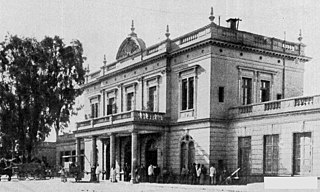
Santa Fe is a railway station located in the city of Santa Fe, Argentina in the province of the same name, Argentina. The station is no longer used for railway services since 2007, when defunct company Trenes de Buenos Aires cancelled its services to Santa Fe.

The CSR EMU is a series of electric multiple unit cars manufactured by CSR Corporation Limited for use on Buenos Aires' commuter rail network. As of 2015, the trains operated on three of the city's lines and 705 cars were manufactured, with each line using a different number of cars per train. They were created for use on lines electrified using both third rail and overhead lines.


















